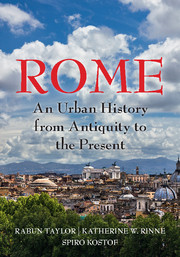Book contents
- Frontmatter
- Dedication
- Epigraph
- Contents
- List of Illustrations
- Acknowledgments
- Map
- INTRODUCTION
- 1 A BEND IN THE RIVER
- 2 A STORYBOOK BEGINNING
- 3 IDEOLOGICAL CROSSFIRE
- 4 BIG MEN ON THE CAMPUS
- 5 RES PUBLICA RESTITUTA
- 6 MEMORIALS IN MOTION: SPECTACLE IN THE CITY
- 7 THE CONCRETE STYLE
- 8 REMAKING ROME'S PUBLIC CORE: I
- 9 REMAKING ROME'S PUBLIC CORE: II
- 10 CRISIS AND CONTINUITY
- 11 RUS IN URBE: A GARDEN CITY
- 12 ADMINISTRATION, INFRASTRUCTURE, AND DISPOSAL OF THE DEAD
- 13 MAPPING, ZONING, AND SEQUESTRATION
- 14 TETRARCHIC AND CONSTANTINIAN ROME
- 15 TROPHIES AND TITULI: CHRISTIAN INFRASTRUCTURE BEFORE CONSTANTINE
- 16 WALLS MAKE CHRISTIANS: FROM FOURTH TO FIFTH CENTURY
- 17 A TALE OF TWO ROMES
- 18 THE ROME OF GOTHS AND BYZANTINES
- 19 CHRISTIAN FOUNDATIONS
- 20 FROM DOMUS LATERANI TO ROMANUM PALATIUM
- 21 THE LEONINE CITY: ST. PETER'S AND THE BORGO
- 22 VIA PAPALIS, THE CHRISTIAN DECUMANUS
- 23 THE URBAN THEATERS OF IMPERIUM AND SPQR
- 24 HOUSING DAILY LIFE
- 25 CHAOS IN THE FORTIFIED CITY
- 26 THE TIBER RIVER
- 27 HUMANIST ROME, ABSOLUTIST ROME (1420–1527)
- 28 PLANNING COUNTER REFORMATION ROME
- 29 PROCESSIONS AND POPULATIONS
- 30 MAGNIFICENT PALACES AND RHETORICAL CHURCHES
- 31 NEOCLASSICAL ROME
- 32 PICTURING ROME
- 33 REVOLUTION AND RISORGIMENTO
- 34 ITALIAN NATIONALISM AND ROMANITÀ
- 35 A CITY TURNED INSIDE OUT
- Glossary of Persons, Places, and Terms
- Works Cited
- Index
33 - REVOLUTION AND RISORGIMENTO
Published online by Cambridge University Press: 05 July 2016
- Frontmatter
- Dedication
- Epigraph
- Contents
- List of Illustrations
- Acknowledgments
- Map
- INTRODUCTION
- 1 A BEND IN THE RIVER
- 2 A STORYBOOK BEGINNING
- 3 IDEOLOGICAL CROSSFIRE
- 4 BIG MEN ON THE CAMPUS
- 5 RES PUBLICA RESTITUTA
- 6 MEMORIALS IN MOTION: SPECTACLE IN THE CITY
- 7 THE CONCRETE STYLE
- 8 REMAKING ROME'S PUBLIC CORE: I
- 9 REMAKING ROME'S PUBLIC CORE: II
- 10 CRISIS AND CONTINUITY
- 11 RUS IN URBE: A GARDEN CITY
- 12 ADMINISTRATION, INFRASTRUCTURE, AND DISPOSAL OF THE DEAD
- 13 MAPPING, ZONING, AND SEQUESTRATION
- 14 TETRARCHIC AND CONSTANTINIAN ROME
- 15 TROPHIES AND TITULI: CHRISTIAN INFRASTRUCTURE BEFORE CONSTANTINE
- 16 WALLS MAKE CHRISTIANS: FROM FOURTH TO FIFTH CENTURY
- 17 A TALE OF TWO ROMES
- 18 THE ROME OF GOTHS AND BYZANTINES
- 19 CHRISTIAN FOUNDATIONS
- 20 FROM DOMUS LATERANI TO ROMANUM PALATIUM
- 21 THE LEONINE CITY: ST. PETER'S AND THE BORGO
- 22 VIA PAPALIS, THE CHRISTIAN DECUMANUS
- 23 THE URBAN THEATERS OF IMPERIUM AND SPQR
- 24 HOUSING DAILY LIFE
- 25 CHAOS IN THE FORTIFIED CITY
- 26 THE TIBER RIVER
- 27 HUMANIST ROME, ABSOLUTIST ROME (1420–1527)
- 28 PLANNING COUNTER REFORMATION ROME
- 29 PROCESSIONS AND POPULATIONS
- 30 MAGNIFICENT PALACES AND RHETORICAL CHURCHES
- 31 NEOCLASSICAL ROME
- 32 PICTURING ROME
- 33 REVOLUTION AND RISORGIMENTO
- 34 ITALIAN NATIONALISM AND ROMANITÀ
- 35 A CITY TURNED INSIDE OUT
- Glossary of Persons, Places, and Terms
- Works Cited
- Index
Summary
AFTER NAPOLEON'S CRUSHING MILITARY DEFEAT AT WATERLOO, THE MAP OF Europe was redrawn at the Congress of Vienna (1814–1815), repatriating most of the Papal States to the Church. As a result, Pius VII returned to Rome and the monasteries were restored. A few years of fragile stability ensued; but waves of violent protest ushered in Pius IX's pontificate and lasted throughout it. Forced to flee Rome during a popular uprising in November 1848, Pius left the city without a government. In February 1849 local revolutionaries held popular elections and declared a new Roman Republic. In exile, the reactionary pope sought military help from French and Spanish troops; these launched an assault on Rome in April. Under the charismatic leader Giuseppe Garibaldi, the Revolutionary Army and hundreds of citizen-soldiers resisted until the end of June, when the French finally gained entry and restored Pius to Rome and his papal seat.
Faced with growing anticlerical sentiment, Pius devised social programs to help stave off local uprisings and embraced urban innovations to modernize Rome. Under his direction a group of advisers and private investors initiated public works projects. These included Rome's first gasworks and gas-lit street illumination, telegraph lines, three Tiber bridges, railroads, and a new aqueduct (Fig. 205). He sponsored housing projects, public fountains and laundries, schools, a new tobacco factory, and an asylum. He also dismantled the Jewish Ghetto's gates.
Nothing epitomized Machine Age modernity more than rail travel, which Pius embraced wholeheartedly. In the 1850s he initiated two passenger and freight lines connecting stations at Porta Maggiore and Porta Portese with a railroad suspension bridge across the Tiber linking via Ostiense to the left bank. The eastern station served both to receive incoming freight and to connect Romans to the countryside. The Porta Portese station emerged from a larger economic vision for Trastevere that included the tobacco factory, worker housing, and the restoration of Ponte Rotto with an iron suspension bridge.
During the 1860s Rome's urban development concentrated on the intramural eastern hills, home to vast estates of Pius IX's former military adviser, the wealthy prelate Francis De Mérode. He donated land in the ancient Castro Pretorio to Pius and then installed a new barracks, parade grounds, and exercise yards for the pope's 1,000 soldiers.
- Type
- Chapter
- Information
- RomeAn Urban History from Antiquity to the Present, pp. 313 - 323Publisher: Cambridge University PressPrint publication year: 2016



